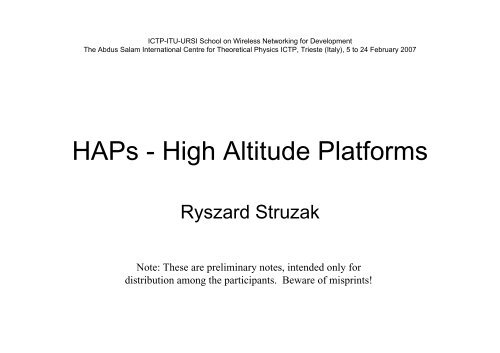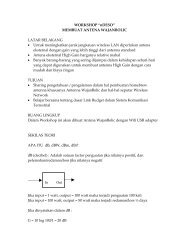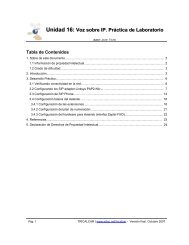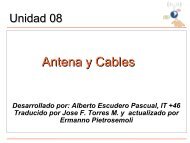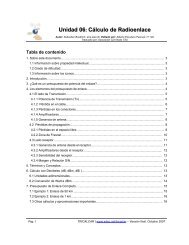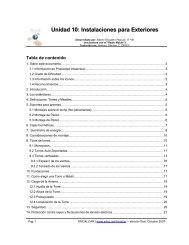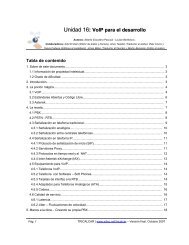HAPs - High Altitude Platforms - Wireless@ICTP
HAPs - High Altitude Platforms - Wireless@ICTP
HAPs - High Altitude Platforms - Wireless@ICTP
You also want an ePaper? Increase the reach of your titles
YUMPU automatically turns print PDFs into web optimized ePapers that Google loves.
ICTP-ITU-URSI School on Wireless Networking for Development<br />
The Abdus Salam International Centre for Theoretical Physics ICTP, Trieste (Italy), 5 to 24 February 2007<br />
<strong>HAPs</strong> - <strong>High</strong> <strong>Altitude</strong> <strong>Platforms</strong><br />
Ryszard Struzak<br />
Note: These are preliminary notes, intended only for<br />
distribution among the participants. Beware of misprints!
• The purpose of the lecture is to discuss one of<br />
new technologies of broadband access using<br />
stratospheric platforms<br />
• Some analysts claimed in 2004 that the<br />
stratospheric radio was the only known<br />
technology that can comprehensively target and<br />
cover the $53B remote area cellular market in a<br />
cost-effective manner.<br />
R. Struzak 2
Topics for discussion<br />
• Introduction<br />
• Stratospheric radio: what is it?<br />
• Few current projects<br />
• Conclusion<br />
R. Struzak 3
Digital divide<br />
R. Struzak 4
Two aspects<br />
• Humanitarian:<br />
– all people should be offered universal access to<br />
information infrastructures<br />
• Economic:<br />
– Wealthy markets are saturated; to keep business<br />
running needed are:<br />
• New services<br />
– E.g. new multimedia wideband interactive applications<br />
• New markets<br />
– E.g. the “poor” market: 85% of the world’s population<br />
– Or nomadic users market: 15% of the population<br />
R. Struzak 5
Hope in radio<br />
Radio waves carry information to fixed & mobile users at no cost<br />
• 300’000 km/s<br />
• Ubiquitous - accessible at any place, any time…*<br />
• Deployment cost & time<br />
• Free, no right-of-way- no deployment/ installation/ maintenance…<br />
• Indestructible - no theft, snow, wind, flood, earthquake, tornado, trees…<br />
• No cable production/ transport/ warehousing…<br />
*Over the Earth’s surface<br />
R. Struzak 6
Line-Of-Sight (LOS) area<br />
A<br />
h<br />
Max LOS cell<br />
P<br />
B<br />
R<br />
tangent cone<br />
O<br />
Shadowed area of the<br />
Earth’s surface<br />
R. Struzak 7
Signal latency restrict interactive applications<br />
1000<br />
GEO<br />
Latency, ms<br />
100<br />
10<br />
1<br />
STR<br />
LEO<br />
MEO<br />
0.1<br />
1.E-01<br />
1.E+00<br />
1.E+01<br />
1.E+02<br />
1.E+03<br />
1.E+04<br />
1.E+05<br />
<strong>Altitude</strong>, km<br />
The time required for a signal to travel from one point on a network to another.<br />
R. Struzak 8
More power for higher altitudes<br />
1.E+08<br />
1.E+07<br />
1.E+06<br />
1.E+05<br />
1.E+04<br />
1.E+03<br />
1.E+02<br />
1.E+01<br />
1.E+00<br />
1.E-02<br />
1.E-01<br />
1.E+00<br />
1.E+01<br />
1.E+02<br />
1.E+03<br />
1.E+04<br />
1.E+05<br />
Relative transm. loss<br />
<strong>Altitude</strong>, km<br />
R. Struzak 9
Launch of GEO satellites<br />
Source: ESA - (Ariane 5)<br />
R. Struzak 10
Power limits for hand-held radio<br />
Head<br />
Unintended<br />
power<br />
Radio waves<br />
interact with<br />
living tissue<br />
Intended<br />
radiation<br />
Radio<br />
Limits:<br />
2.7mW/cm 2 (6min.)<br />
or 8W/kg (for any gram of tissue)<br />
Source: J. Lin: Wireless communication radiation and its biological effects, Global Communications Interactive 1998<br />
R. Struzak 11
Launch of LEO satellites<br />
R. Struzak (Source: Orbital Science Corp., 1998) 12
Low-Earth-Orbit Constellations<br />
• At lower<br />
altitudes<br />
satellites move<br />
relative to the<br />
earth<br />
• Satellite<br />
constellations<br />
are needed to<br />
assure<br />
continuous<br />
communications<br />
R. Struzak 13
What is stratospheric radio?<br />
• A way to keep antenna fixed at stratospheric heights<br />
(~20 km) with multiple applications:<br />
– Civilian Telecommunications Fixed & Mobile:<br />
• Broadband data – Multimedia – Interactive<br />
services - Direct broadcasting – Video on demand<br />
– Emergency - etc. …<br />
– Exploration, Environment, Navigation,<br />
Transportation, Military, …<br />
R. Struzak 14
Why stratospheric heights?<br />
120<br />
100<br />
80<br />
Mesopause<br />
<strong>Altitude</strong>, km<br />
60<br />
40<br />
Stratopause<br />
Stratosphere<br />
20<br />
Tropopause<br />
0<br />
0 10 20 30 40 50 60 70<br />
Wind speed, m/s<br />
R. Struzak 15
1987 SHARP: The first experiment<br />
Power beam:<br />
5.8 GHz, 500 kW<br />
Powering antenna<br />
80 m diameter<br />
Flight zone:<br />
2 km diameter circle,<br />
21 km altitude<br />
Control & contents signals<br />
Coverage zone:<br />
500 km horizon<br />
Earth surface<br />
On 17 Sept. 1987, the Canadian Stationary <strong>High</strong> <strong>Altitude</strong> Relay Platform (SHARP)<br />
prototype makes history by flying for twenty minutes, powered by microwaves (An official<br />
flight takes place on October 7)<br />
R. Struzak 16
SHARP (model)<br />
Source: http://www.friendsofcrc.ca/SHARP/sharp.html<br />
R. Struzak 17
1997: 10 years passed…<br />
• The SHARP project was abandoned, but<br />
some limited research continued<br />
• In 1997 - real “explosion” of projects<br />
• A number of organizations are now<br />
involved<br />
– China, Germany, Hungary, Indonesia, Italy,<br />
Japan, Korea, Slovenia, Spain, Switzerland,<br />
UK, USA…<br />
R. Struzak 18
What happened in 1997?<br />
• HAPS<br />
recognized by<br />
the ITU Radio<br />
Regulations<br />
Board as a new<br />
category of<br />
radio stations<br />
(The author stays 2 nd from left)<br />
This decision has removed obstacles/ uncertainties<br />
in financing the development of that new technology<br />
R. Struzak 19
WRC Geneva 1997<br />
• The decision of RRB has been confirmed by consensus<br />
of all ITU Member Countries at the World<br />
Radiocommunication Conference (WRC) Geneva 1997<br />
R. Struzak 20
WRC Istanbul 2000<br />
The ITU Radiocommunication Assembly<br />
and World Radiocommunication<br />
Conference Istanbul 2000:<br />
• allocated frequency<br />
bands near 20 GHz<br />
for HAPS and<br />
• made appropriate<br />
provisions in the<br />
international treaty<br />
(Radio Regulations)<br />
R. Struzak 21
IMT-2000: flexible, multifunctional<br />
Satellite<br />
Global<br />
HAPS<br />
Suburban<br />
Urban<br />
In-Building<br />
Macrocell<br />
Microcell<br />
Picocell<br />
Basic Terminal<br />
PDA Terminal<br />
Audio/Visual Terminal<br />
R. Struzak 22
2 categories<br />
• Aerodyne:<br />
– A heavier-than-air aircraft deriving lift from<br />
motion relative to surrounding air<br />
• Aerostat:<br />
– A balloon or dirigible, deriving its lift from the<br />
buoyancy of surrounding air rather than from<br />
aerodynamic motion.<br />
R. Struzak 23
Powering<br />
• Periodical refueling<br />
– Combustion engine (Gasoline)<br />
– Nuclear engine (Thermoelectric)<br />
• Receiving energy from the earth<br />
–Microwaves<br />
– Laser<br />
• Capturing solar energy (day) + fuel cells<br />
(night)<br />
R. Struzak 24
Stratospheric radio family<br />
– HALE: <strong>High</strong> <strong>Altitude</strong> Long Endurance<br />
– HAPS: <strong>High</strong> <strong>Altitude</strong> Platform Station<br />
– SHARP: Stationary <strong>High</strong> <strong>Altitude</strong> Relay<br />
Platform<br />
– SPR: Stratospheric Platform Radio<br />
– “Stratospheric Satellite”<br />
– All at the altitude 15 – 30 km<br />
R. Struzak 25
HALO Network<br />
3 Proteus<br />
airplanes<br />
(900 kg)<br />
per city<br />
Source: IEEE Communications Magazine June 2000 p. 143<br />
R. Struzak 26
Proteus<br />
http://www.dfrc.nasa.gov/Newsroom/FactSheets/FS-069-DFRC.html<br />
R. Struzak 27
Predator<br />
R. Struzak 28
Helios<br />
R. Struzak 29
Sad news<br />
• On June 26, 2003, the Helios aircraft was<br />
lost in the Pacific Ocean, 29 minutes after<br />
takeoff during a test flight (Kauai island,<br />
Hawaii)<br />
• The flight was to checkout the operation of<br />
a new fuel cell system developed for<br />
overnight flight operation in the<br />
stratosphere<br />
R. Struzak 30
Sky Station International<br />
2100 Cells<br />
Urban<br />
Sub-Urban<br />
Rural<br />
R. Struzak 31
“Stratospheric satellites”<br />
•“Super-pressure"<br />
balloons powered by<br />
solar array.<br />
•Carrying remote<br />
sensing or telecom.<br />
payloads up to 2 tons<br />
•Can be steered and<br />
directed to fly over<br />
and monitor specific<br />
areas, with a<br />
trajectory control<br />
•Would augment and<br />
complement many<br />
satellites<br />
Model of Fully-Pressurized Balloons In Flight. Picture courtesy of NASA.<br />
R. Struzak 32
StratoSat <br />
• Constellations of<br />
StratoSat platforms would<br />
circle the Earth at an<br />
altitude of 35 km<br />
• Key features:<br />
(a) affordable, longduration<br />
balloon systems<br />
(b) balloon flight path<br />
control capability,<br />
(c) constellation geometry<br />
management, and<br />
(d) a global<br />
communications<br />
infrastructure.<br />
R. Struzak 33
StratoSat TM (cont)<br />
• Projected life: 3-10 years.<br />
• The projected life-cycle cost < $400,000/<br />
unit, or 10 to 100 times less than aircraft or<br />
space satellite communications platforms<br />
• Current project: A constellation of 400<br />
Stratospheric Satellites to cover most of the<br />
northern hemisphere. Cost: < $160 million +<br />
< $10 million per year of operations costs<br />
• Source: http://www.gaerospace.com/ (June<br />
2002).<br />
R. Struzak 34
StratoSat test flight 10 Mar 2001<br />
• Picture courtesy of NASA<br />
R. Struzak 35
Range comparison<br />
100000<br />
Earth diameter<br />
10000<br />
Max. Footprint Diameter, km<br />
1000<br />
100<br />
Minimum elevation<br />
angle (= 0)<br />
15 deg.<br />
45 deg.<br />
10<br />
Terrestrial HAPS LEO MEO GEO<br />
1<br />
1.E-02 1.E-01 1.E+00 1.E+01 1.E+02 1.E+03 1.E+04 1.E+05<br />
<strong>Altitude</strong>, km<br />
R. Struzak 36
Earth observation resolution<br />
Satellite<br />
d D h<br />
= ⇒ d = D<br />
h H H<br />
D<br />
H<br />
HAPS<br />
h<br />
d<br />
The same optical system<br />
Example 1: SPOT2<br />
H = 820km<br />
D=<br />
10m<br />
Example 2: HAPS<br />
h=<br />
20km<br />
20<br />
d = 10m× ≈0.25m<br />
822<br />
R. Struzak 37
Maximum power-flux density<br />
0<br />
Power Flux Density, W/sqm*MHz<br />
-50<br />
-100<br />
-150<br />
-200<br />
0 10 20 30 40 50 60 70 80 90<br />
Angle-of-arrival above the horizon, degrees<br />
R. Struzak 38
Conclusion<br />
• With all promises fulfilled, stratospheric radio will<br />
facilitate the access to modern information<br />
structures<br />
• Emergency telecommunications<br />
• Nomadic users<br />
• Sparsely-populated and remote regions<br />
• Lower-income social strata<br />
• Will impact the business of the existing terrestrial<br />
& satellite services<br />
• Will create new EMC problems<br />
R. Struzak 39
To learn more…<br />
• A recent PPT presentation:<br />
http://www.stratxx.com/slides/index.html<br />
• A number of bibliographic positions and<br />
Web references are given in<br />
– Struzak R: “Mobile telecommunications via<br />
stratosphere”;<br />
http://www.intercomms.net/AUG03/docs/featu<br />
res.php<br />
–<br />
R. Struzak 40
• Display of a film<br />
R. Struzak 41
Any questions?<br />
Thank you for your attention<br />
R. Struzak 42
Ryszard STRUZAK PhD., DSc.<br />
Co-Director, ICTP-ITUD School on Wireless<br />
Networking, IT<br />
Academician, International<br />
Telecommunication Academy<br />
Life Fellow IEEE<br />
ryszard@struzak.com<br />
www.ryszard.struzak.com<br />
Important notes<br />
Copyright © 2007 Ryszard Struzak. This work is<br />
licensed under the Creative Commons Attribution<br />
License (http://creativecommons.org/<br />
licenbses/by/1.0) and may be used freely for<br />
individual study, research, and education in notfor-profit<br />
applications. Any other use requires the<br />
written author’s permission. These materials and<br />
any part of them may not be published, copied to<br />
or issued from another Web server without the<br />
author's written permission. If you cite these<br />
materials, please credit the author.<br />
Beware of misprints!!! These materials are<br />
preliminary notes for my lectures and may contain<br />
misprints. If you notice some, or if you have<br />
comments, please send these to<br />
r.struzak@ieee.org.<br />
R. Struzak 43


